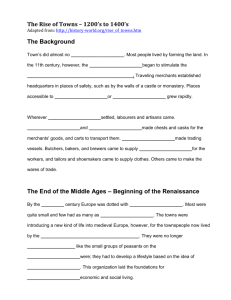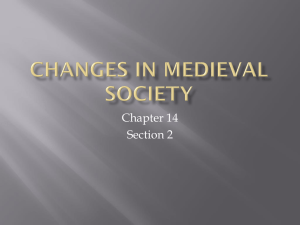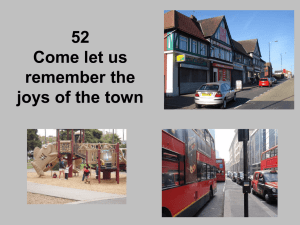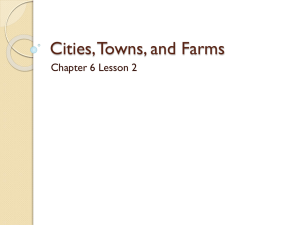Trade and Towns
advertisement
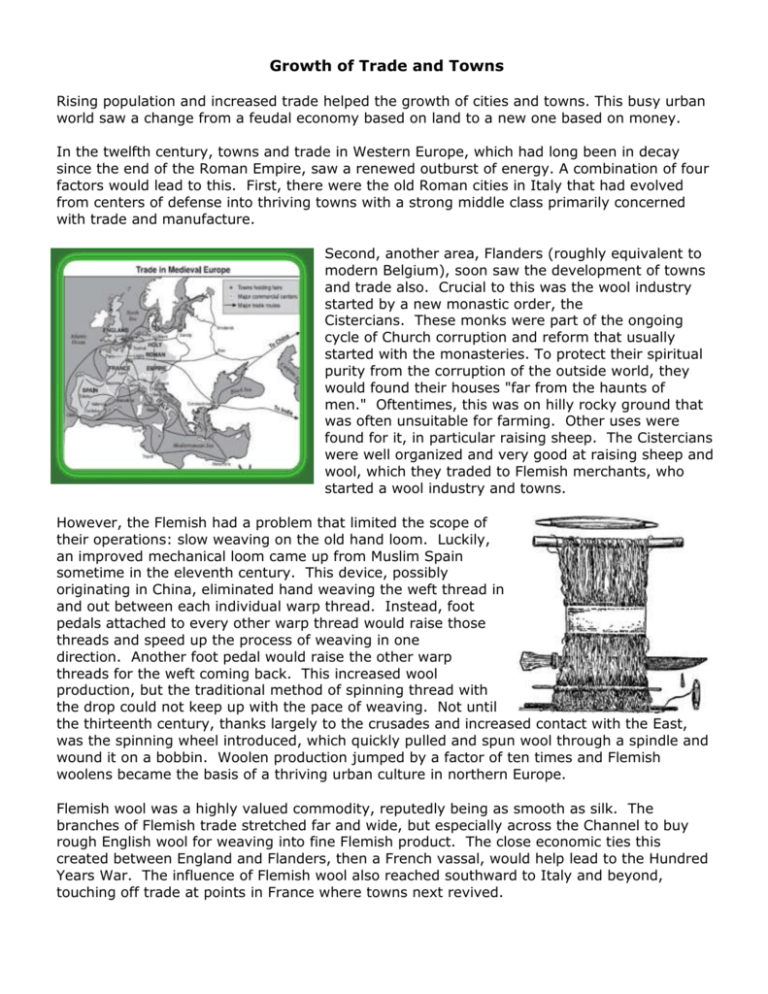
Growth of Trade and Towns Rising population and increased trade helped the growth of cities and towns. This busy urban world saw a change from a feudal economy based on land to a new one based on money. In the twelfth century, towns and trade in Western Europe, which had long been in decay since the end of the Roman Empire, saw a renewed outburst of energy. A combination of four factors would lead to this. First, there were the old Roman cities in Italy that had evolved from centers of defense into thriving towns with a strong middle class primarily concerned with trade and manufacture. Second, another area, Flanders (roughly equivalent to modern Belgium), soon saw the development of towns and trade also. Crucial to this was the wool industry started by a new monastic order, the Cistercians. These monks were part of the ongoing cycle of Church corruption and reform that usually started with the monasteries. To protect their spiritual purity from the corruption of the outside world, they would found their houses "far from the haunts of men." Oftentimes, this was on hilly rocky ground that was often unsuitable for farming. Other uses were found for it, in particular raising sheep. The Cistercians were well organized and very good at raising sheep and wool, which they traded to Flemish merchants, who started a wool industry and towns. However, the Flemish had a problem that limited the scope of their operations: slow weaving on the old hand loom. Luckily, an improved mechanical loom came up from Muslim Spain sometime in the eleventh century. This device, possibly originating in China, eliminated hand weaving the weft thread in and out between each individual warp thread. Instead, foot pedals attached to every other warp thread would raise those threads and speed up the process of weaving in one direction. Another foot pedal would raise the other warp threads for the weft coming back. This increased wool production, but the traditional method of spinning thread with the drop could not keep up with the pace of weaving. Not until the thirteenth century, thanks largely to the crusades and increased contact with the East, was the spinning wheel introduced, which quickly pulled and spun wool through a spindle and wound it on a bobbin. Woolen production jumped by a factor of ten times and Flemish woolens became the basis of a thriving urban culture in northern Europe. Flemish wool was a highly valued commodity, reputedly being as smooth as silk. The branches of Flemish trade stretched far and wide, but especially across the Channel to buy rough English wool for weaving into fine Flemish product. The close economic ties this created between England and Flanders, then a French vassal, would help lead to the Hundred Years War. The influence of Flemish wool also reached southward to Italy and beyond, touching off trade at points in France where towns next revived. The emerging feudal order helped make possible two other factors vital to the rise of towns and trade. One was the agricultural revolution that could support town populations. The other was the end of Viking and Arab raids that made the roads safer for trade. These four factors helped create more political stability, which encouraged merchants to take to the roads once again. In the middle of the old Roman trade routes linking Italy and Flanders was the French county of Champagne, whose counts were shrewd enough to take advantage of this trade by sponsoring six annual trade fairs held in four rotating locations. Rather than robbing these merchants, the counts charged them for the use of booths, local justice, lodging, food, and protection. Among those attending these fairs and providing the counts with revenues were wealthy merchants from Italy and Flanders. The excitement these fairs generated was infectious. So were the profits. Some jealous nobles attacked and robbed merchants traveling to the fairs. Others, being more far-sighted, worked to ensure safer travel so they could start their own fairs and make their own profits. With each new fair came greater incentive to stifle troublesome local nobles and increase political order. This in turn stimulated more trade fairs, more profits, more law and order, and so on. Eventually fairs and trade became so common that merchants started settling down in permanent towns. Generally, such settlements were on well-traveled routes that could attract the trade of passing merchants. They also were under the protective walls of a lord's castle, an abbot's monastery, or a bishop's settlement. Many towns were brand new settlements, but others were outgrowths of already established communities. Even today, many European towns have a castle in or near them, evidence of their medieval beginning. The Revival of Trade More stable conditions had helped produce the rise of towns. The towns in turn helped create even more peaceful conditions with far reaching effects. For one thing, towns generated taxes in the form of money, a new wealth superior to land as the primary form of riches. Previously, almost any noble with a castle and a stockpile of food could defy his lord by going under siege, since feudal armies were notoriously unstable and prone to breaking up after their terms of service (usually forty days) were up. However, the more powerful lords that could attract settlers for towns now had money from taxes. With that money, they could buy mercenaries, usually landless knights, who would fight as long as the lord could pay them. Such armies were more stable and allowed their owners to crush the power of their rebellious vassals and establish more law and order. The increased order would encourage more towns which would generate more taxes for the king and upper nobles, who could impose even more law and order, and so on. This would also feed back into the ongoing cycle encouraging trade fairs. All this led to two things: a rising class of townsmen and a money based economy, both of which would help lead to the rise of kings. In the towns the houses were packed together because every town had to be a fortress, with stout, high walls and a moat or river to protect it from hostile nobles, pirates, and robber bands. The smaller the walled enclosure, the easier it was to defend. The only open places were the market square in the town center, the cathedral, and the few gardens of the rich. Main streets led like spokes of a wheel from the market to the few gates in the walls. Building room was so cramped that the houses were built in several narrow stories, the upper floors jutting over the alley-like streets. Few streets were paved. In wet weather people floundered almost knee-deep in mud. The street was the only sewer. It sloped to the center, and refuse and chamber waste were flung into it. Pigs rooted in the odorous filth. Wells, springs, and rivers were the only water supply. They were unprotected and untreated, so that plagues were frequent. Houses were uncomfortable. Most of them had a mere framework of heavy timbers. The wall spaces were filled with woven reeds daubed with clay or plaster. Rushes or straw usually lined the floors. Fireplaces had chimneys, and the peril of sparks on the thatched roofs was one of the worst hazards of town living. The house of the average citizen served multiple functions as his dwelling, factory, and shop. Goods were made and sold on the ground floor. The owner and his family lived on the floor above. The upper stories of the house were storage rooms and sleeping lofts for the workmen. At night the medieval city was dark and dangerous. There were no street lights. People who ventured out at night took along one or two workmen with lanterns and weapons as a protection against robbers. In some cities cables were strung across streets to hinder fleeing criminals. Few working citizens, however, went out at night. The workday began at sunrise and ended at sunset. At 8 or 9 PM the cathedral bell tolled the curfew. This was the signal to cover all fires with ashes to lessen the peril of houses catching fire in the night. Money created another problem especially hurting the nobles and Church: inflation. At first, when towns were just getting started and there was little money in circulation, the fixed rent set by the original town charter seemed like a good deal. However, as more money came into circulation, prices rose, and the buying power of the fixed rents declined. This especially hurt the nobles and the Church. This gave them some immediate cash, but wrecked much of their power, leading to the decline and eventual end of the feudal order. The Church, with its wealth mostly in land and fixed rents, also suffered. It did have other options for raising money, namely selling church offices and indulgences (reprieves from punishment in Purgatory before being admitted into Heaven). Such practices were subject to abuse and led to popular discontent that cut into the Church's power and prestige. Eventually, that would lead to the Protestant Reformation, which would destroy the Catholic Church's religious dominance in Western Europe. As far as townsmen were concerned, nobles and churchmen first saw them as an asset providing them with taxes and militia. However, as the class of townsmen grew, so did tensions with their overlords. For one thing, townsmen (or burghers, from burg, the German word meaning town) felt increasingly held back under a lord's rule. The two classes had very different values, the burghers being concerned with trade and commerce and their overlords being concerned with power and fighting. Therefore, one by one, towns started trying to gain their freedom. Some towns bought it with one big payment to the lord or fought for it, sometimes in long protracted struggles. For example, the town of Tours in France fought twelve wars before it finally won its independence. Another tactic was to appeal to the king for support, since kings and townsmen saw each other as valuable allies against the nobles and Church in between. Eventually, the towns managed to break free and form communes (urban city-states) like their counterparts in Italy. Oftentimes approving the town’s independent status would be a charter that would detail the specific duties and liberties the town and lord owed each other. Also, as serfs and towns bought their freedom, they came more closely under the king's authority, supplying him with taxes and loans. Two other factors gave the king an edge over other nobles. One was his religious position as God's appointed ruler, which was symbolized by a churchman anointing him with oil in the same manner as Biblical rulers. The second factor was his position as the supreme judge of the land. When the kings were weak in the Early Middle Ages, this did them little good. However, as they rose in power, they could exercise their judicial powers more effectively, which in turn would give them more political power and so on. All these factors, the rise of a money economy, the growing class of townsmen, and the kings' judicial and religious status gradually led to the decline of the medieval Church and nobles and the corresponding rise of kings with money that could buy them two things. One was stable full time mercenary armies that would fight for as long as they were paid. The other was a government drawn increasingly from the middle class. These had several advantages over feudal vassals. For one thing, they were more loyal, being the king's natural allies against the nobles. Also, they were more efficient since they were generally literate and could keep records. Finally, they were easier to control because they were totally dependent on the king for their status. Also, they were paid with money, so the king could just cut their pay if they got out of line. This contrasted greatly with the land based economy of the Early Middle Ages when the king had to physically drive rebellious vassals from their lands. Although the rise of kings and national monarchies would be a centuries-long process, it was the rise of towns starting in the twelfth century that set that process in motion and laid the foundations of the modern world. A Medieval City
